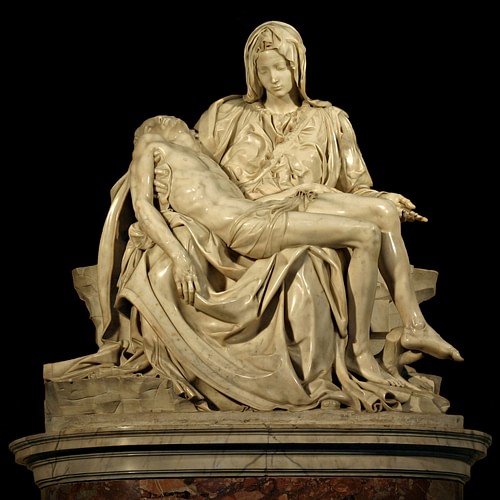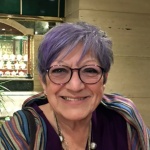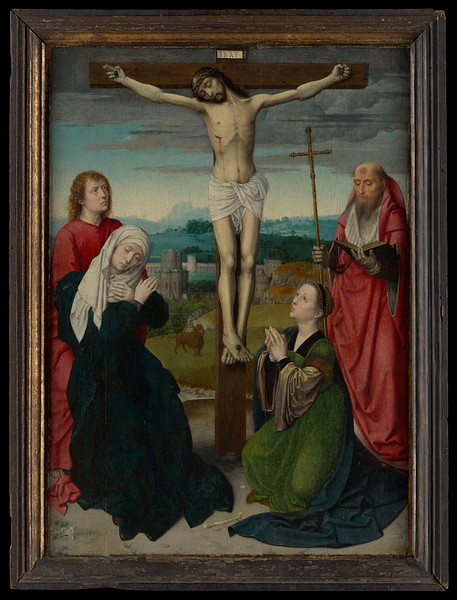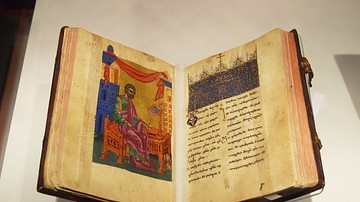
Mary of Nazareth, the mother of Jesus Christ, is one of the most venerated women from the ancient world. Her most common epithet is "the virgin Mary." She is celebrated by Eastern Orthodox Churches, Catholicism, and various Protestant denominations as "the mother of God." In Islam, Surah 19 of the Quran, the surah of Maryam, is devoted to her.
Stories of Mary evolved over time. Our earliest source for Christianity are the letters of Paul the Apostle to the Gentiles. Written before the canonical gospels, Paul did not name her. We have only: "But when the fullness of time had come, God sent his son, born of a woman, born under the law" (Galatians 4:4).
Mary in the Gospels
Ancient cultures shared a conviction that great people often had a miraculous birth, usually with the mating of a god with a human woman.
The gospels of Mark, Matthew, Luke, and John (70-100 CE) are our sources for Mary. Confusing at times, there are many women named Mary in the gospels. Then (as now) people named their children after famous figures. The name Mary derived from the Aramaic Mariam, in koine Greek, Maria. Miriam was the sister of Moses.
The earliest gospel, Mark (c. 70 CE), began in medias res, with the adult Jesus beginning his ministry in Nazareth:
On the Sabbath he began to teach in the synagogue, and many who heard him were astounded. They said, "Where did this man get all this? What is this wisdom that has been given to him? What deeds of power are being done by his hands! Is not this the carpenter, the son of Mary and brother of James and Joses [Joseph] and Judas and Simon, and are not his sisters here with us?" And they took offense at him.
(Mark 6:2-3)
Although not described as a follower in the earthly ministry, we know that his brother James was a historical figure because Paul visited with him twice, and he is referred to as "James, the Lord's brother" in Galatians 1:18. In Acts, James is one of the leaders of the new movement in Jerusalem. Early Christianity understood the siblings as other children of Mary after the birth of Christ.
Matthew and Luke both began their gospels with a birth story, the nativity of Jesus. The motivation was most likely to convince people that Jesus was the messiah, predicted by the prophets of Israel. They did this through references to the books of the prophets in the Jewish scriptures. At the same time, ancient cultures shared a conviction that great people often had a miraculous birth, usually with the mating of a god with a human woman.
Matthew's gospel describes the birth of Jesus as follows:
Now the birth of Jesus the messiah took place in this way. When his mother Mary had been engaged to Joseph, but before they lived together, she was found to be pregnant from the holy spirit. Her husband Joseph, being a righteous man and unwilling to expose her to public disgrace, planned to divorce her quietly. But just when he had resolved to do this, an angel of the Lord appeared to him in a dream and said, "Joseph, son of David, do not be afraid to take Mary as your wife, for the child conceived in her is from the holy spirit." All this took place to fulfill what had been spoken by the Lord through the prophet: "Look, the virgin shall become pregnant and give birth to a son, and they shall name him Emmanuel," which means, "God is with us." When Joseph awoke from sleep, he did as the angel of the Lord commanded him; he took her as his wife but had no marital relations with her until she had given birth to a son, and he named him Jesus."
(Matthew 1:18-23)
The holy spirit at this point was not the third entity of what became the Trinity in 325 CE. It was a reference to the spirit of God, which animated Adam when he "breathed into his nostrils the breath of life, and the man became a living being" (Genesis 2:7). It was the spirit of God that possessed the prophets with the ability to speak in God's name and perform miracles.
Readers are sometimes confused with a reference to divorce, as they were not married yet. Both betrothals and marriages were done through a legal contract, exchanging the property of the father to the new husband. To undo an original contract, another contract, that of divorce, was required.
Mary, the Virgin
The above passage is famous for translation issues between Hebrew and Greek, which established the virginity of Mary. Around 200 BCE, the Hebrew scriptures were translated into Greek in Alexandria, Egypt, known as the Septuagint. This is the version that the gospel writers used. However, it contains several loose translations. Matthew turned to Isaiah 7. Isaiah was the prophet during the Assyrian conquest in 722 BCE. Ahaz was an evil king of Judah (732-716 BCE). God told him to ask for a sign, but he refused: "Therefore the Lord himself will give you a sign. Look, the young woman is with child and shall bear a son and shall name him Immanuel" (Isaiah 7:14). The Hebrew almah, translated here as "young woman" was a girl who had passed puberty, ready to procreate. In translating this to Greek, almah became parthenos, a "virgin".
"Virgin" did not necessarily relate to an intact hymen; it was a general term for an unmarried woman. "Virgin" was a common metaphor for innocence and purity, the state of the young before puberty and adulthood. The temple to Athena was named the Parthenon as "the virgin Goddess" because Athena chose to rule alone, without a consort or husband, and had no children.
In Matthew, the birth of Jesus takes place off-stage, with few details. Joseph was told in a dream to take the family and flee to Egypt because King Herod intended to slaughter all two-year-old boys in fear of a new king that would usurp his rule. The Orthodox Coptic Church of Egypt venerates sacred sites where the family found shelter at oases and wells on this journey.
The Nativity in Luke's Gospel
Luke provided a more elaborate background and details to the story of Mary and the birth of Jesus. He began with the story of Zechariah and Elizabeth, a barren couple. In his rotation as high priest in the Temple, Zechariah was visited by an angel who told him that they would become the parents of John, the Baptist.
In the sixth month the angel Gabriel was sent by God to a town in Galilee called Nazareth, to a virgin engaged to a man whose name was Joseph, of the house of David. The virgin's name was Mary. And he came to her and said, "Greetings, favored one! The Lord is with you." But she was much perplexed by his words and pondered what sort of greeting this might be. The angel said to her, "Do not be afraid, Mary, for you have found favor with God. And now, you will conceive in your womb and bear a son, and you will name him Jesus. He will be great and will be called the son of the most high, and the Lord God will give to him the throne of his ancestor David. He will reign over the house of Jacob forever, and of his kingdom there will be no end." Mary said to the angel, "How can this be since I am a virgin?" [Greek: "I do not know a man"]. The angel said to her, "The holy spirit will come upon you, and the power of the most high will overshadow you; therefore the child to be born will be holy; he will be called son of God. And now, your relative Elizabeth in her old age has also conceived a son, and this is the sixth month for her who was said to be barren. For nothing will be impossible with God." Then Mary said, "Here am I, the servant of the Lord; let it be with me according to your word."
(Luke 1:26-38)
The annunciation to Mary became iconic in later Renaissance art. The Feast Day of the Annunciation is celebrated on 25 March, nine months before December.
Mary then visited Elizabeth, and in this passage, "relative" was later translated as "cousin":
When Elizabeth heard Mary's greeting, the child leaped in her womb. And Elizabeth was filled with the holy spirit and exclaimed with a loud cry, "Blessed are you among women, and blessed is the fruit of your womb. And why has this happened to me, that the mother of my Lord comes to me? For as soon as I heard the sound of your greeting, the child in my womb leaped for joy."
(Luke 1:41-44)
In other words, even in the womb, John recognized the superiority of Jesus. Between the 6th and 11th centuries, the announcement to Mary and this passage became incorporated into what became known as "the Hail Mary," a ritual prayer:
Hail Mary, full of grace,
the Lord is with you;
blessed are you among women
and blessed is the fruit of your womb, Jesus.
Holy Mary, mother of God,
pray for us sinners,
now and at the hour of our death.
Pope Gregory the Great (served 590-604) was credited with using this prayer in the liturgy. Saint Dominic (1170-1221) was visited by an angel who told him to teach people to use beads to keep track of prayers, the rosary. The rosary remains a devotional ritual to Mary.
While Matthew claimed that the family originally lived in Bethlehem and later moved to Nazareth, Luke used the device of registering for the Roman census to get Joseph and Mary to Bethlehem. When there was no room in the upper story of the waystation for travelers (the inn), the birth in Luke took place on the lower floor where animals were kept, in the stable.
Mary and Joseph circumcised Jesus, and Mary went to the Temple in Jerusalem to complete the required purification after the birth of a child, with her offering of "two turtledoves." In the Temple, she encountered Simeon who predicted:
This child is destined for the falling and the rising of many in Israel and to be a sign that will be opposed so that the inner thoughts of many will be revealed—and a sword will pierce your own soul, too.
(Luke 2:34-35)
This became the tradition of the sufferings of Mary, ultimately placing her as among the highest of the martyrs, the Queen of Heaven.
Mark and Matthew list several women named Mary who witnessed the trial and crucifixion of Jesus of Nazareth. One of them, "Mary, the mother of James and Joseph," may be a reference to her. Luke only mentioned a group of women, mourning at the event. In the Acts of the Apostles, Luke mentioned Mary only once. She was present with the disciples when Mattathias was selected to replace Judas: "All these were constantly devoting themselves to prayer, together with certain women, including Mary the mother of Jesus, as well as his brothers" (Acts 1:14).
Mary in John's Gospel
The Gospel of John has no physical birth of Jesus; he was the manifestation of the word of God on earth (the logos). This became the Christian concept of the incarnation in which Jesus pre-existed in heaven and appeared in a human body on earth. At the same time, however, John also incorporated the mother of Jesus, although never named. In John 2:1-12, Jesus' mother convinced him to turn the water into wine at the wedding in Cana. Later, John also places her at the site of the crucifixion:
Meanwhile, standing near the cross of Jesus were his mother, and his mother's sister, Mary the wife of Clopas, and Mary Magdalene. When Jesus saw his mother and the disciple whom he loved standing beside her, he said to his mother, "Woman, here is your son." Then he said to the disciple, "Here is your mother." And from that hour the disciple took her into his own home. (John 19: 25-27)
Later traditions identified "the disciple whom he loved" as John, the brother of James, one of the sons of Zebedee. There were stories that this John survived and worked in Ephesus where he took Mary. Modern Christians tour the excavations of the "house of John and Mary" in modern Ephesus. This scene also became a popular depiction in later Christian iconography, with Mary and John at the foot of the cross.
Other Texts
In the 2nd century CE, we have The Protoevangelium of James, explaining what happened before the good news of the gospels. We learn that Mary's parents were a barren couple, Joachim and Anna. Praying to God for a child, Anna promised to "dedicate the child to God" if he granted her prayer. After Mary was weaned, Anna took her to be raised by the priests in Temple. This provided Mary with the distinction of never having been exposed to the evils of the outside world.
When she reached puberty, they had a contest for her marriage. Joseph won because his farmer's staff miraculously blossomed. This text claimed that Mary and Joseph never had sexual relations after the birth of Jesus. In this version, a midwife examined Mary and verified that the hymen was still intact, even after the birth. The excavated house of Anna and Joachim is open to tourists and pilgrims in the Old City of Jerusalem.
Not recorded in the New Testament, the earliest evidence for the death of Mary dates from a 4th-century CE text, Treatise About the Passing of the Blessed Virgin Mary. The apostles were with Mary when she died. Angels then took her body to heaven. The New Testament always refers to believers who die as "falling asleep", and a Victorian edifice, the Church of the Dormition on Mt. Zion claims to be the site where Mary "fell asleep" and ascended to heaven.
Mary in Islam
In the Islamic Quran, Maryam is extolled by the faithful as the greatest woman, chosen, and purified by God. Her story is related in a surah devoted to her. Following the tradition, the angel Gabriel informed her that she would conceive a child through the divine spirit, who would be the promised messiah (Isa, Jesus). Maryam and Isa were the only two who could not be touched by the Devil (Iblis). The distinction in Islam, however, is that worship is solely for God, although Maryam and Isa can be venerated.
Mary in Late Antiquity & the Middle Ages
With the deification of Jesus with the attributes of God, the status of Mary had to change. Beginning in the 2nd century CE, Christians granted Mary the title Theotokos ("God-bearer") because she carried divinity in her womb. This made her a 'divine vessel,' untainted by sexual intercourse. This led to a readjustment concerning the list of brothers in the gospels. Two theories were proposed:
- the brothers in the gospels were actually cousins
- they were step-brothers from a previous marriage of Joseph, who had been a widower.
Mary was granted the official status of 'perpetual virgin' at the Council of Constantinople in 553 CE. As her son had brought forgiveness for the sin of Adam, Mary undid the sin of Eve and became the ideal role model for women. Throughout the Middle Ages, there were feast days for Mary, special prayers and devotions in her name, and churches and shrines as pilgrimage sites for events in her life. Mary could intercede in the lives of believers and help alleviate those awaiting in purgatory.
With an increased interest in the cult of Mary, paintings and statues proliferated as the Madonna ("my lady") during the period of the Renaissance. During the Roman Empire, Mary as mother was aligned with the Egyptian goddess Isis who also protected mothers and children. A seated Mary with the baby Jesus on her lap became iconic.

One of the most famous images of Mary is Michelangelo's (1475-1564), sculpture known as the Pieta, housed in St. Peter's Basilica in Rome. Pieta ("pity") recognizes the suffering of Mary when she held Jesus as he was taken down from the cross.
Appearances by Mary
Augustine of Hippo (354-430 CE) created the concept of original sin, that all humans inherited the sin of Adam and Eve. Jesus was conceived by "the spirit of God," but what about Mary?
In Lourdes, France in 1858, a peasant girl, Bernadette Soubirous (1844-1879), claimed to see "a great lady" when she was gathering firewood who told her to build a chapel near a cavern with a spring. She asked the lady her name, and Mary replied, "I am the immaculate conception" (conceived without original sin). An uneducated peasant would have no concept of this, and so it was declared a miracle. Bernadette was canonized as a saint in 1933, and Lourdes remains famous for miraculous cures.
There have been several miraculous appearances by Mary, usually in the context of cultural upheaval or crises. She appeared to Juan Deigo, a Mexican peasant in the Spanish territories in 1531 (Our Lady of Guadalupe). In Fatima, Portugal in 1917, she appeared to three children, offering messages that predicted WWI and WWII. In 1981, six teenagers experienced visions of Mary in Medjugorje, in Bosnia and Herzegovina. The visions included admonitions to the faithful, especially priests, to help people and believe even without visions. Thousands of pilgrims visit these sites.









